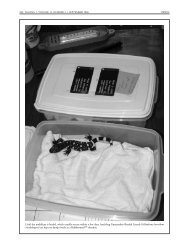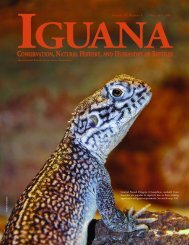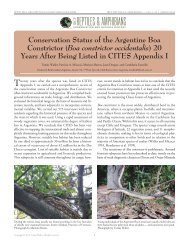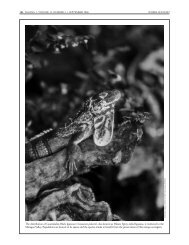Spiny-tailed Iguanas (Ctenosaura similis) in Venezuela
Spiny-tailed Iguanas (Ctenosaura similis) in Venezuela
Spiny-tailed Iguanas (Ctenosaura similis) in Venezuela
Create successful ePaper yourself
Turn your PDF publications into a flip-book with our unique Google optimized e-Paper software.
JOHN BINNS<br />
146 IGUANA • VOLUME 15, NUMBER 3 • SEPTEMBER 2008 COTÍ AND ARIANO-SÁNCHEZ<br />
with<strong>in</strong> a distance of 200 m. Two females were recorded mak<strong>in</strong>g<br />
use of only two shelters.<br />
Feed<strong>in</strong>g Habits<br />
We exam<strong>in</strong>ed 19 fecal samples (9 from females and 11 from<br />
males). The diet consists ma<strong>in</strong>ly of <strong>in</strong>sects (47.83%) and plant<br />
material such as flowers (15.37%), fruits (7.69%,), and leaves<br />
(26.92%). The most frequently represented <strong>in</strong>sects were ants<br />
(19%) and crickets (15.38%). One fecal sample conta<strong>in</strong>ed large<br />
numbers of fly larvae that may have been <strong>in</strong>gested adventitiously<br />
with fruit. Species recognized <strong>in</strong> the plant material were leaves<br />
of Licania hypoleuca, flowers of Cochlospermum vitifolium, and<br />
the fruits and seeds of Stenocereus pru<strong>in</strong>osus. We also found<br />
stones and res<strong>in</strong>.<br />
We frequently have seen C. palearis feed<strong>in</strong>g on fruits of S.<br />
pru<strong>in</strong>osus. Faces and forelimbs colored by the red pigment of this<br />
Evidence of the feed<strong>in</strong>g habits of Guatemalan Beaded Lizards<br />
(Heloderma horridum charlesbogerti). The crushed eggshell on the right<br />
was found <strong>in</strong>side the nest of an iguana. Also found <strong>in</strong> the same nest<br />
were sk<strong>in</strong> remnants from a Guatemalan Beaded Lizard.<br />
A male <strong>Ctenosaura</strong> palearis on the branch of a Timboque tree<br />
(Tecoma stans) displays his dewlap.<br />
Biologist Paola Coti with her first-ever captured <strong>Ctenosaura</strong> palearis. The<br />
male <strong>in</strong> the photo was the first marked with PIT tags for the project.<br />
cactus fruit are a common site. We captured three <strong>in</strong>dividuals<br />
with evidence of residual pulp and seeds stuck to their faces.<br />
These fruits are available from March through early May.<br />
Food varied by season. The samples from May to September<br />
were composed ma<strong>in</strong>ly of leaves, fibers, and ants. In contrast, samples<br />
from November to December had smaller quantities of fiber<br />
and an <strong>in</strong>creased number of leaf sprouts. Samples from February<br />
to March conta<strong>in</strong>ed flowers, beetles, crickets, and ants (and other<br />
hymenopterans). Sample sizes were too small to determ<strong>in</strong>e if<br />
observed seasonal differences were significant.<br />
Reproduction<br />
Female C. palearis have an annual reproductive cycle.<br />
Copulation occurs dur<strong>in</strong>g January and February, and gravid<br />
females are found <strong>in</strong> February and March. Females dig sand tun-








